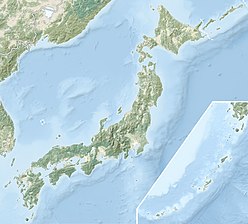Mt. Tsukuba
| Mount Tsukuba | |
|---|---|
| 筑波山 | |

A view from Chikusei city
|
|
| Highest point | |
| Elevation | 877 m (2,877 ft) |
| Listing | 100 famous mountains in Japan |
| Coordinates | 36°13.31′N 140°06.24′E / 36.22183°N 140.10400°ECoordinates: 36°13.31′N 140°06.24′E / 36.22183°N 140.10400°E |
| Geography | |
| Location | Ibaraki, Japan |
| Geology | |
| Mountain type | granite, gabbro |
Mount Tsukuba (筑波山 Tsukuba-san) is an 877 m (2,877 ft) mountain located near Tsukuba, Japan. It is one of the most famous mountains in Japan, particularly well known for its double peaks, Nyotai-san 877 m (2,877 ft) and Nantai-san 871 m (2,858 ft). Many people climb the so-called "purple mountain" every year for the panoramic view of the Kantō plain from the summit. On clear days the Tōkyō skyline, Lake Kasumigaura and even Mount Fuji are visible from the mountain top. Most mountains in Japan are volcanic, but Mount Tsukuba is composed of non-volcanic rocks such as granite and gabbro. The area surrounding the mountain is known to produce beautiful granite, and many rock quarries still mine it today.
The Fudoki of Hitachi Province (常陸国風土記 Hitachi no kuni Fudoki), a national geography completed in 721 AD, says Mount Tsukuba was named after a noble called Tsukuha no Mikoto (筑箪命). According to this account, the area around Mount Tsukuba was once called Ki no kuni (紀国). Under the reign of Mimaki no Sumeramikoto (美麻貴天皇) (Emperor Sujin), Tsukuha no Mikoto from the Uneme clan (采女氏) was appointed as its governor. He had a strong desire to leave his name in history, so he renamed the area "Tsukuha", which is now pronounced Tsukuba.
As legend has it, thousands of years ago, a deity descended from the heavens and asked two mountains for a place to spend the night. With its great summit and almost perfect cone, Mt. Fuji refused, believing with pride and arrogance that it does not need the deity's blessings. Mt. Tsukuba, on the other hand, humbly welcomed the honored guest, even offering food and water. Today, Mt. Fuji is a cold, lonely, and barren mountain, while Mt. Tsukuba bursts with vegetation and is filled with colors as the seasons change.
...
Wikipedia

